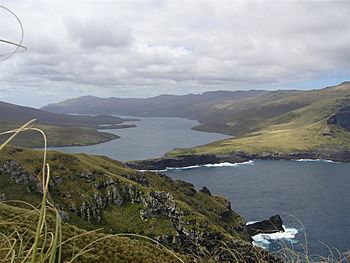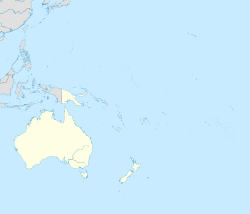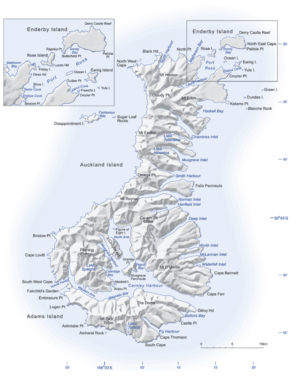Auckland Island facts for kids
|
Mauka Huka
|
|
|---|---|

Carnley Harbour and Adams Island
|
|
|
New Zealand Subantarctic Islands
|
|
| Geography | |
| Coordinates | 50°41′S 166°05′E / 50.69°S 166.08°E |
| Archipelago | Auckland Islands |
| Area | 442.5 km2 (170.9 sq mi) |
| Length | 42 km (26.1 mi) |
| Width | 26 km (16.2 mi) |
| Highest elevation | 659 m (2,162 ft) |
| Highest point | Cavern Peak |
| Administration | |
|
New Zealand
|
|
Auckland Island (called Mauka Huka in Māori) is the main island of the Auckland Islands. This group of islands is not inhabited by people and is located in the Pacific Ocean. It's part of the New Zealand subantarctic area. The island, along with others in the New Zealand Subantarctic Islands group, is a special place listed on the UNESCO World Heritage list.
Contents
Island Geography
Auckland Island covers an area of about 442.5 square kilometers (171 square miles) and is 42 kilometers (26 miles) long. It was formed a very long time ago, between 25 and 10 million years, from a huge volcano. This volcano created two main dome-shaped areas. One is around Carnley Harbour in the south, and the other is near Disappointment Island to the west.
The island is made of volcanic rock called scoria, which is covered by more than 2 meters (6.5 feet) of peat (a type of soil made from decayed plants). Auckland Island is known for its very steep cliffs and rough land, which rises to over 600 meters (2,000 feet) high. Some of its highest points include Cavern Peak (659 meters or 2,162 feet), Mount Raynal (635 meters or 2,083 feet), Mount D'Urville (630 meters or 2,067 feet), Mount Easton (610 meters or 2,001 feet), and the Tower of Babel (550 meters or 1,804 feet).
The southern part of the island is wider, about 26 kilometers (16 miles) across, and includes Carnley Harbour. On the western side, a very narrow waterway called Victoria Passage separates Auckland Island from the smaller Adams Island. Adams Island and the southern part of the main island together form the edge of a volcano crater. Cape Lovitt, which is the westernmost point of New Zealand, is about 3 kilometers (2 miles) north of the entrance to Carnley Harbour.
Plant Life

There are 233 different types of vascular plants (plants with roots, stems, and leaves) found on the Auckland Islands. Out of these, 163 are native to the islands, and 23 were brought there by people. Eight types of plants are found only on these islands and nowhere else in the world.
The island has different areas with distinct types of plants. Along the coast, except on the western side, there's a band of Southern rātā trees (Metrosideros umbellata). How tall these trees grow depends on how much shelter they get from the wind and how steep the land is. The rātā forest often blends into areas of Chionochloa tussock grasslands. However, in most places, it changes into a thick band of low, dense scrub. This scrub is mainly made up of plants like Dracophyllum longifolium, Ozothamnus vauvilliersii, and Myrsine divaricata. This scrub can be so thick that it's almost impossible to walk through, and in some spots, it's so dense you can even walk on top of it!
An expedition in 1907 described this scrub as being "extremely toilsome" to get through. They said it was four to six feet high and very hard to push aside.
Beyond the scrub, there are large areas of Chionochloa antarctica grasslands. These grasslands then lead to areas with very few plants, known as fellfield communities, in the most exposed high-altitude spots. Large, leafy plants called megaherbs, such as Anisotome antipoda and Bulbinella rossii, used to grow from the coast all the way up to the mountains. However, their numbers and where they grow have been greatly affected by pigs that were brought to the island.
Marine Animals
Port Ross at the northern end of Auckland Island is the only place in New Zealand where Southern right whales, known as tohorā (Eubalaena australis), come to have their babies. Up to 400 of these whales can be found in the harbor during the winter months. Scientists from the University of Otago regularly check on them.
A group of New Zealand sea lions also lives and has their young on the island. About 80% of all New Zealand sea lions live and breed in the Auckland Islands. The New Zealand Department of Conservation has been counting these sea lions every year since 1994.
Bird Life
The Auckland Island group is recognized as an Important Bird Area (IBA) by BirdLife International. This means it's a very important place for many types of seabirds to breed.
Several bird species are found only on the Auckland Islands. These include the Gibson's albatross (Diomedea antipodensis gibsoni), Auckland shag (Leucocarbo colensoi), Auckland teal (Anas aucklandica), Auckland rail (Lewinia muelleri), and Auckland snipe (Coenocorypha aucklandica). Right now, only the shags are breeding on the main Auckland Island. They do this in areas where introduced cats and pigs cannot reach their nests.
The Auckland Island merganser (Mergus australis), a type of duck, became extinct in 1902. It's thought that there were only 20–30 breeding pairs before pigs and cats, which were brought to the island, started preying on them. The last known bird was collected for a museum in January 1902.
| English name | Māori name | Scientific name | New Zealand Threat Status | Estimated no. breeding pairs on Auckland Islands group | Percentage of world population on Auckland Islands group | Status on main Auckland Island |
|---|---|---|---|---|---|---|
| Gibson's albatross | Diomedea antipodensis gibsoni | Nationally critical | > 5,800 | 100 | Rare | |
| Southern royal albatross | Toroa | Diomedea epomophora | Naturally uncommon | < 100 | 1 | Rare, breeding |
| Northern royal albatross | Toroa | Diomedea sanfordi | Naturally uncommon | 2 | < 0.01 | Absent |
| NZ white-capped albatross | Thalassarche cautasteadi | Declining | 95,900 | > 99 | Local colonies | |
| Light-mantled sooty albatross | Pēō / kōputu / toroa haunui / toroa ruru / toroa pango | Phobetria palpebrata | Declining | < 5,000 | < 23 | Occasional |
| Northern giant petrel | Pāngurunguru | Macronectes halli | Naturally uncommon | 340 | 3 | Rare |
| Yellow-eyed penguins | Hoiho / takaraha | Megadyptes antipodes | Nationally vulnerable | < 550 | 35–40 | Breeding |
| Eastern rockhopper penguin | Eudyptes filholi | Nationally critical | < 3,000 | 1 | Local colonies | |
| Erect-crested penguin | Eudyptes sclateri | Declining | No recent records | Unknown | Absent | |
| Snares Cape petrel | Daption capense australe | Naturally uncommon | > 10 | 1 | Absent | |
| White-chinned petrel | Procellaria aequinoctialis | Declining | > 153,000 | 13 | Absent | |
| White-headed petrel | Pterodroma lessonii | Not threatened | > 100,000 | 40 | Absent | |
| Sooty shearwater | Tītī (juve.) hakoko (ad.) / hākēkeke / koakoa / totorore / takakau / ōi | Puffinus griseus | Declining | > 10,000 | < 1 | Absent |
| Subantarctic diving petrel | Pelecanoides urinatrixexsul | Not threatened | > 1,000 | < 1 | Absent | |
| Black-bellied storm petrel | Fregetta tropica | Not threatened | > 10,000 | > 10 | Absent | |
| NZ white-faced storm petrel | Takahikare / takahikare-moana | Pelagodroma marina maoriana | Relict | > 10 | < 1 | Absent |
| Grey-backed storm petrel | Reoreo | Garrodia neresis | Relict | > 1,000 | > 10 | Absent |
| Lesser fulmar prion | Pachyptia crassirostris | Naturally uncommon | < 1,000 | 100 | Absent | |
| Antarctic prion | Totorore / whiroia | Pachyptila desolata | Naturally uncommon | 100,000 | < 1 | Rare |
| Auckland Island shag | Kōau / kawau
general name for shag or cormorant |
Leucocarbo colensoi | Nationally vulnerable | 1,500 | 100 | Rare |
| New Zealand Antarctic tern | Sterna vittata bethunei | Recovering | > 50 | > 10 | Rare | |
| Southern white-fronted tern | Sterna sterna | Declining | > 50 | < 1 | Rare | |
| Red-billed gull | Tarāpunga / akiaki / katatē / taketake / makorā / karehākoa | Larus novaehollandiae scopulinus | Nationally vulnerable | < 300 | < 1 | Rare |
| Southern Black-backed Gull | Rāpunga / karoro / kōtingotingo (juve.) / pohio (juve.) / kaiē (juve.) / toie (chick) | Larus dominicanus dominicanus | Not threatened | < 500 | < 1 | Occasional |
| Subantarctic brown skua | Hākoakoa | Catharacta antarctica lonnbergi | Naturally uncommon | > 50 | < 1 | Occasional |
| Auckland Island teal | Tētē whero | Anas aucklandica | Nationally vulnerable | 500 | 100 | Absent |
| New Zealand falcon | Karearea | Falco novaeseelandiae | Nationally vulberable | > 15 | > 1 | Rare |
| Auckland Island banded dotterel | Pohowera / piopio / | Charadrius bicinctus | Naturally uncommon | > 300 | 100 | Rare |
| Auckland Island rail | Lewinia muelleri | Naturally uncommon | Unknown | 100 | Absent | |
| Auckland Island snipe | Hōkio / hākuai/ hākuwai / hōkio | Coenocorypha aucklandica aucklandica | Naturally uncommon | Unknown | 100 | Absent |
| Ruddy turnstone | Arenaria interpres | Migrant | Regular in small numbers | < 0.1 | Rare | |
| Auckland Island tomtit | Ngirungiru / piropiro / kōmiromiro | Petroica macrocephela marrineri | Naturally uncommon | Unknown | 100 | Breeding |
| Auckland Island pipit | Hīoi / pīhoihoi / whioi / kātaitai / whāioio / manu kahaki | Anthus novaeseelandiae aucklandicus | Recovering | > 1,000 | 100 | Breeding |
| Red-crowned parakeet | Kakariki / porete / kākāwaiariki / kākāwariki / kawariki / pōreterete / pōwhaitere / torete / tōreterete | Cyanoramphus novaezelandiae | Relict | Unknown | Unknown | Occasional |
| Yellow-crowned parakeet | Kakariki / porete / kākāwaiariki / kākāwariki / kawariki / pōreterete / pōwhaitere / torete / tōreterete | Cyanoramphus auriceps | Not threatened | Unknown | Unknown | Rare |
| Tui | Tui | Prosthemadera novaeseelandiae | Not threatened | Unknown | Unknown | Occasional |
| Bellbird | Korimako | Anthornis melanura | Not threatened | Unknown | Unknown | Common |
| Silvereye | Pihipihi / tauhou / hiraka / iringatau / kanohi mōwhiti / mōtengitengi / pīkaraihe / poporohe / whiorangi | Zosterops lateralis | Not threatened | Unknown | Unknown | Common |
Introduced Species and Conservation
Auckland Island currently has animals that were brought there by humans, which are now causing problems for the native wildlife. These include pigs, cats, and mice. Auckland Island is the only one of the New Zealand Subantarctic Islands that still has these harmful introduced mammals. The Department of Conservation is planning a project to remove these pests from the island. They started testing ways to do this in 2018.
Mice
Scientists have studied the DNA of the mice (Mus musculus) on Auckland Island. They found that these mice didn't come from New Zealand. Instead, they likely arrived with whalers or seal hunters from North America. Mice eat insects, seeds, other plant parts, and even native fish eggs. They can also eat bird eggs and chicks. They cause big problems by reducing insect populations, eating seeds and young plants, and competing with birds for food.
Cats
Domestic cats (Felis catus) were first seen on the island in 1840. They were probably brought by sealers even earlier. The negative effect of cats on Auckland Island's birds was noticed by 'Coastwatchers' during World War II. These people even tamed some cats, and records show that cats at Ranui Station killed 60 Antarctic prions (a type of seabird) in just three months in 1942. A scientist named Brian Bell found in 1962 that prions could only nest on cliff faces because any bird that landed elsewhere was quickly caught by wild cats. Studies of cat stomachs and droppings show that they eat small songbirds and seabirds. A cat was even seen eating a young white-capped mollymawk (a type of albatross) before it could fly.
Goats
Goats were brought to the Auckland Islands several times in the late 1800s. The idea was to provide food for sailors who might get shipwrecked there. By the 1970s, only about 100 goats were left, living on the northwest side of Port Ross. These goats caused a lot of damage to the native tussock grasslands. In 1986 and 1987, over 60 goats were taken off the island to be bred in New Zealand. The decision was then made to remove all remaining goats from the island, which was completed by 1992. Sadly, an investigation in 1999 found that the special breed of Auckland Island goats that were moved to New Zealand had died out.
Pigs
Pigs (Sus scrofa) were first brought to Port Ross in the north of Auckland Island in 1807 by Captain Abraham Bristow. More pigs were released in the 1800s. Like the goats, these pigs were meant to be a food source for shipwreck survivors and sealers. The Auckland Island pigs are now a wild type of domestic pig. They are considered a unique breed by the Rare Breeds Conservation Society of New Zealand. Pigs have caused severe damage to the populations of megaherbs. By the early 1900s, almost all of these large plants on Auckland Island had been eaten by pigs.
Other Introduced Plants and Animals
Some birds that were introduced to mainland New Zealand have also naturally made their way to Auckland Island. These include Dunnocks, common redpolls, Eurasian blackbirds, song thrushes, and common starlings.
A tree called Oleria lyalli, which is native to New Zealand, might have arrived with humans in the 1800s. It is now spreading from an old settlement site at Erebus Cove and covers the nearby Ewing Island. Another plant, Harakeke (New Zealand flax), is found in places like Erebus Cove and Sealer's Creek. It was probably brought by sealers to make rope, twine, baskets, and mats. Kormiko (Hebe salicifolia) was first reported in 1975 near the Lindley Point farmhouse, which was built in 1851.
Human History on the Island
There is proof from old artifacts that people from Polynesians briefly lived on the Auckland Islands about 600–700 years ago, but then left. Later, Māori and Moriori people from the Chatham Islands settled at Ranui Cove from 1842 to 1856. Auckland Island was also the site of a failed settlement called Hardwicke. It was started in 1849 but only lasted three years before being abandoned in 1852.
In 1864, two ships, the Grafton and the Invercauld, were wrecked on Auckland Island. Groups of survivors from each ship lived on opposite ends of the island, not knowing the other group was there. The Grafton survivors lived on the island for 18 months. They built a boat and sailed to New Zealand to get help. The Invercauld survivors camped in the remains of Hardwicke, but sadly, all but three of them died before they were rescued.
In 1874, a German expedition came to Terror Cove in Port Ross to observe the Transit of Venus, a rare event where Venus passes in front of the Sun.
During World War II, 'Coastwatchers' from the Cape Expedition were stationed on the island from March 1941 to October 1945. They built two stations: one at Ranui Cove in Port Ross and another at Tagua, on Musgrave Peninsula in Carnley Harbour. A base at Waterfall Inlet was used as a docking spot for the ship Ranui, which supplied these stations.
See also
 In Spanish: Isla Auckland para niños
In Spanish: Isla Auckland para niños



